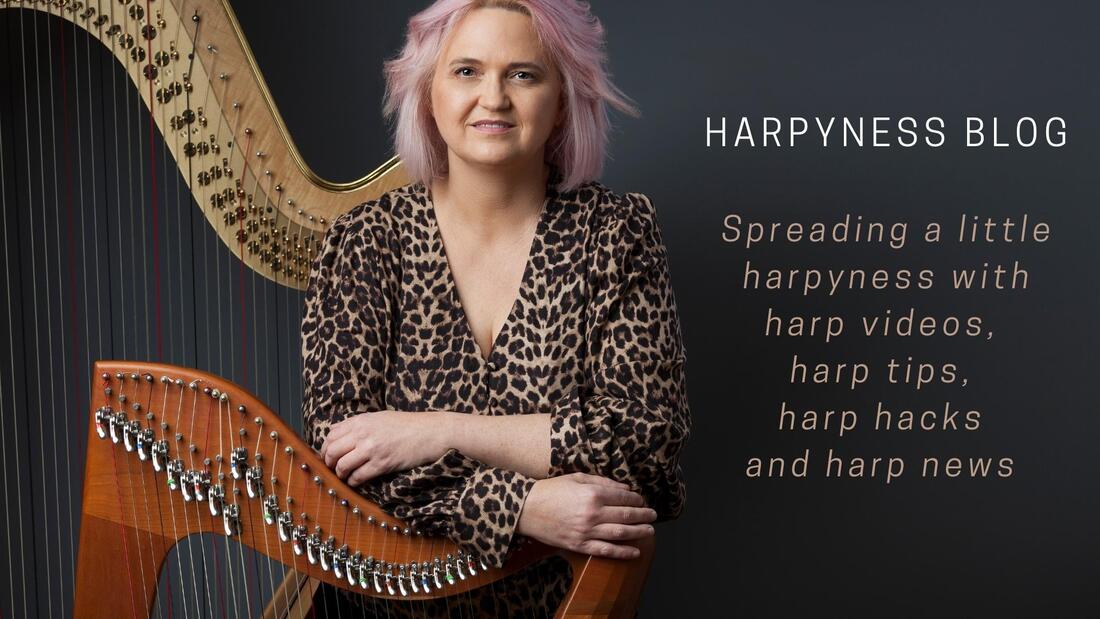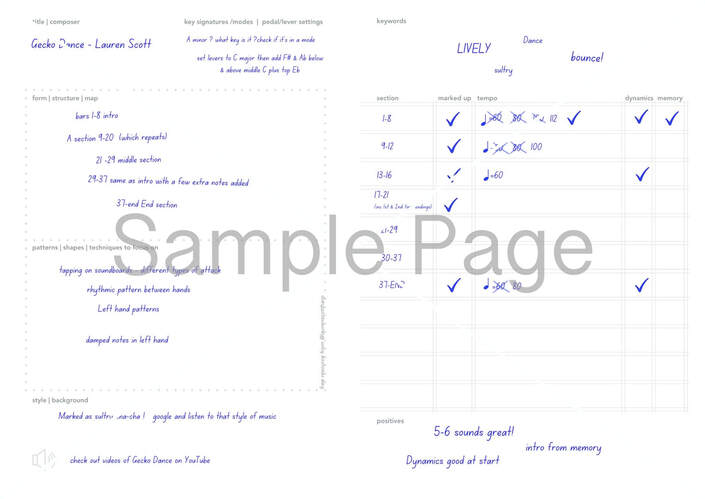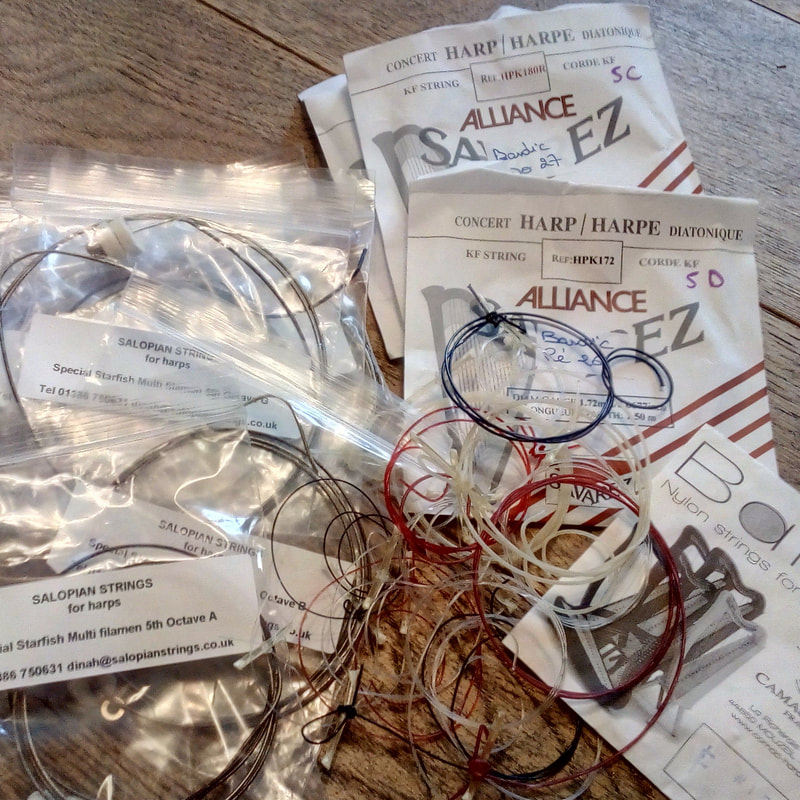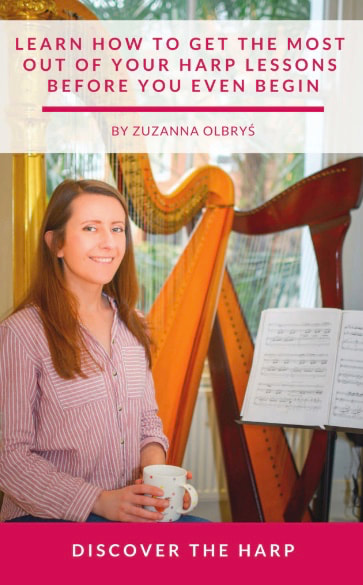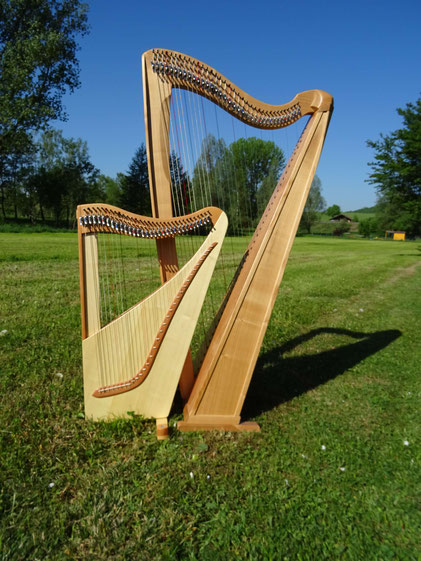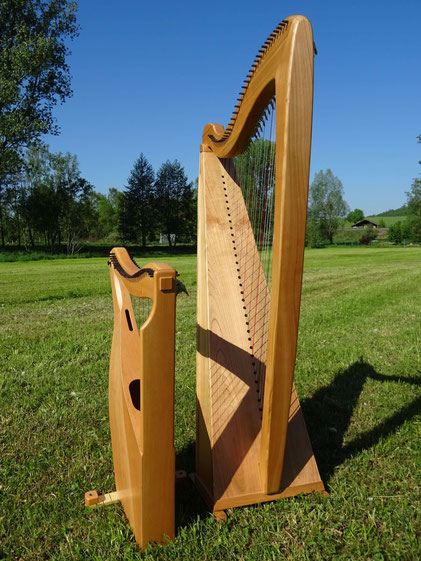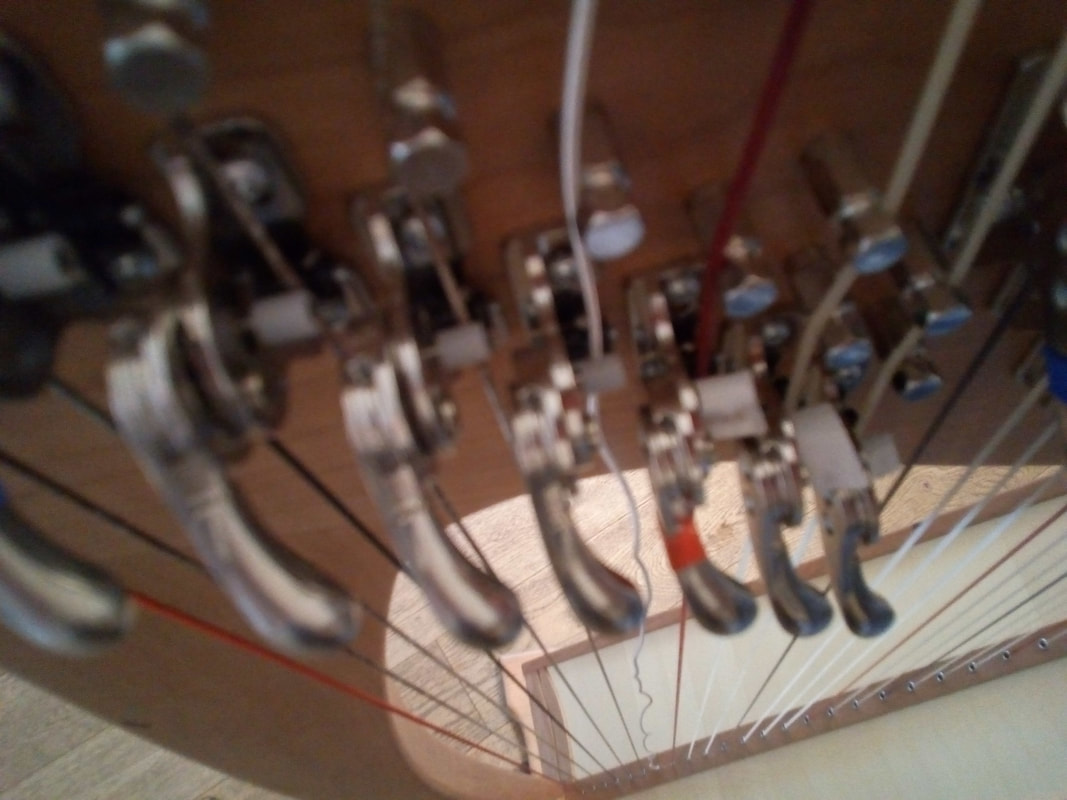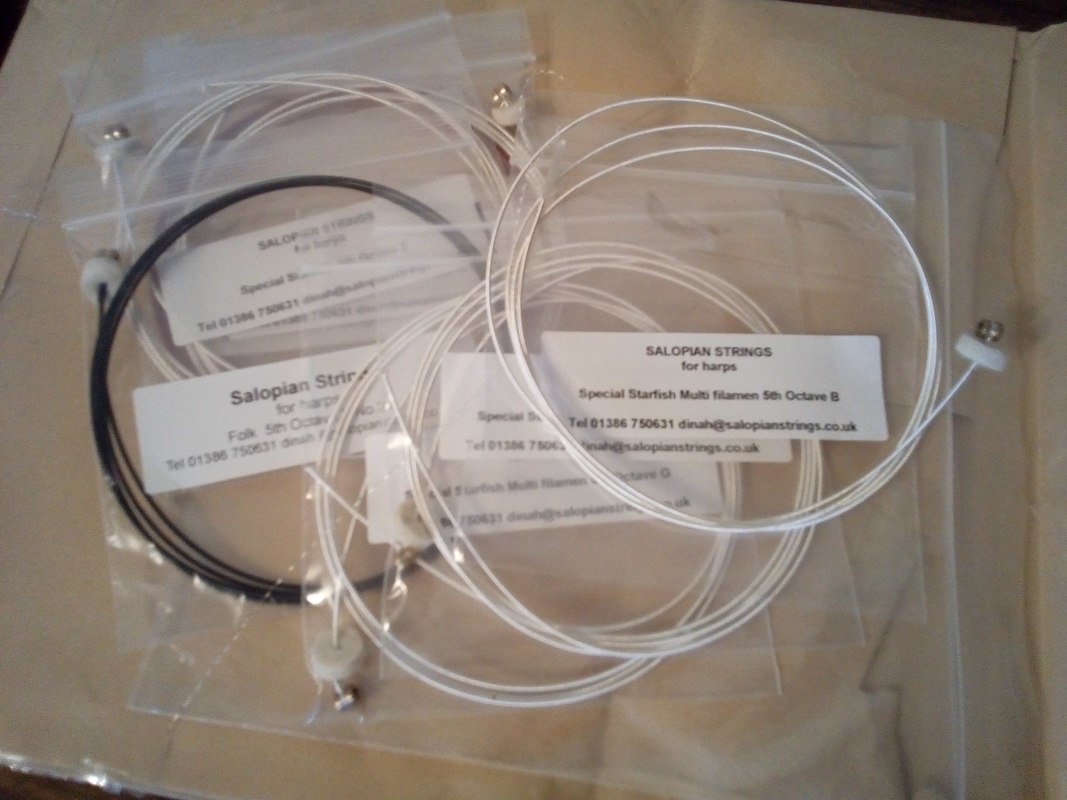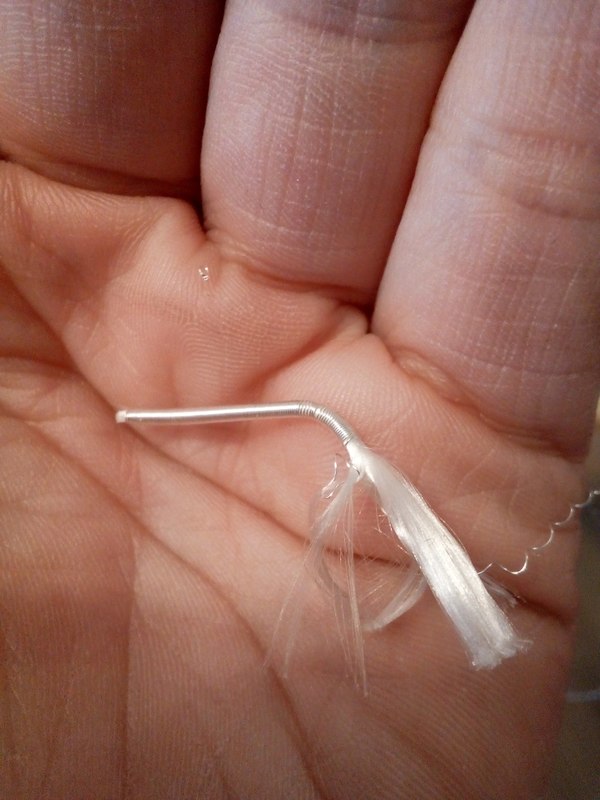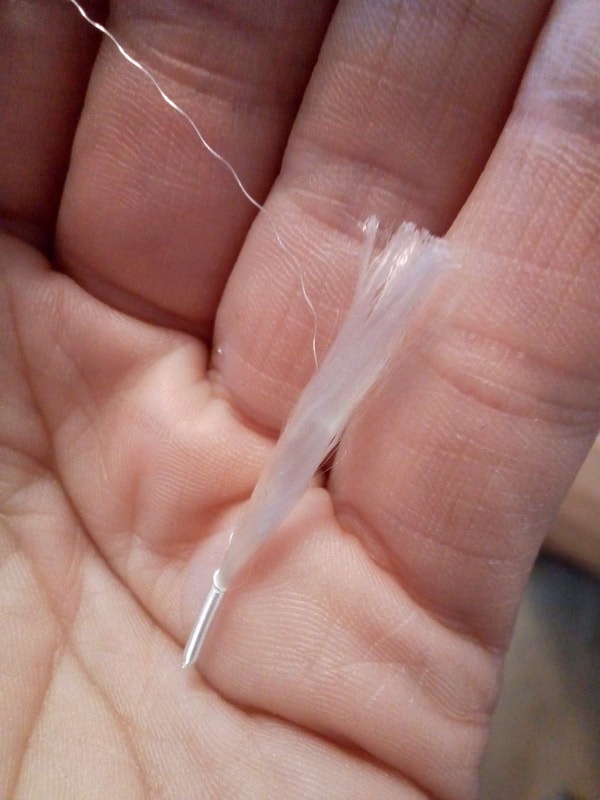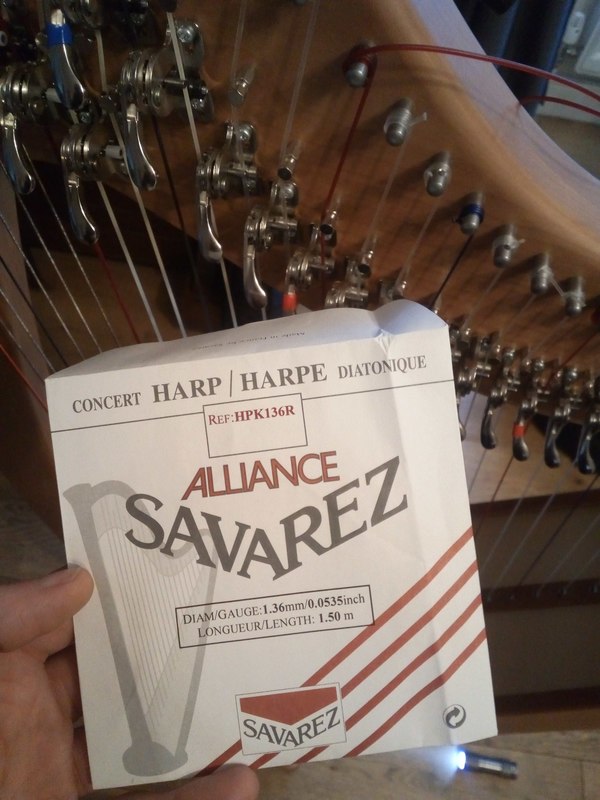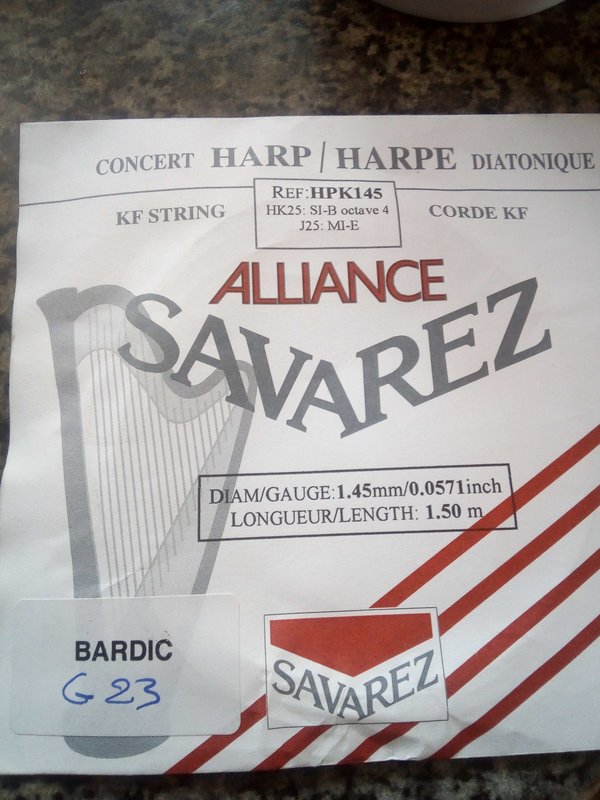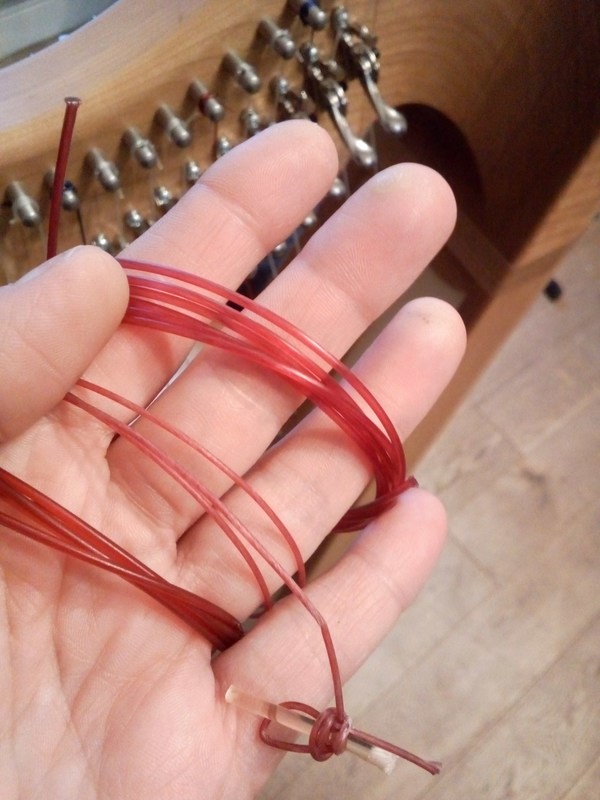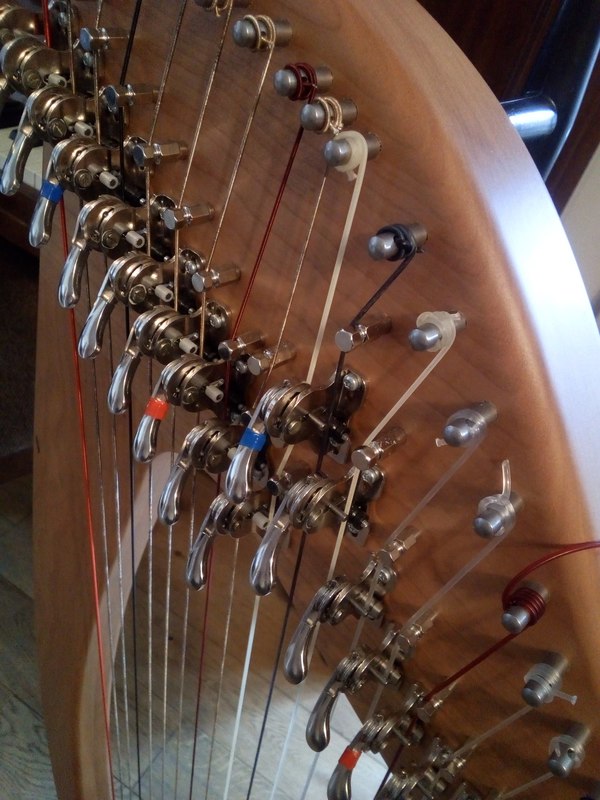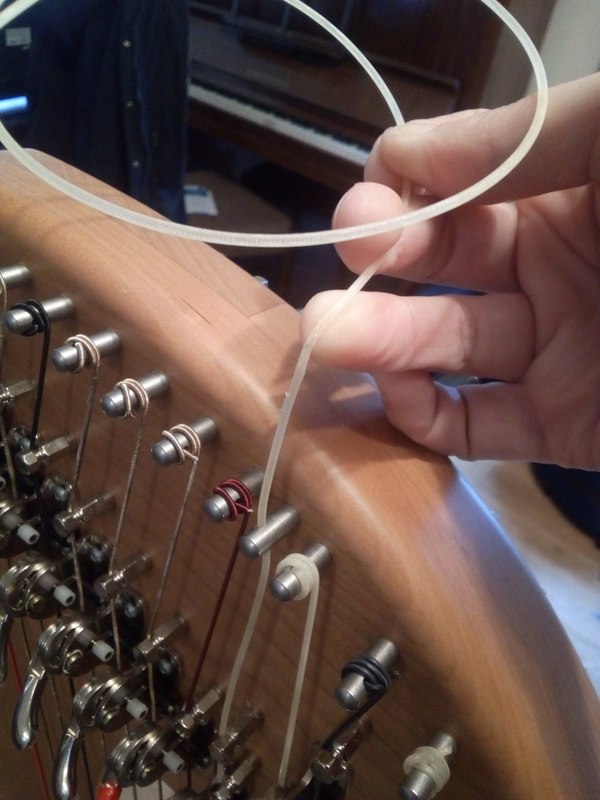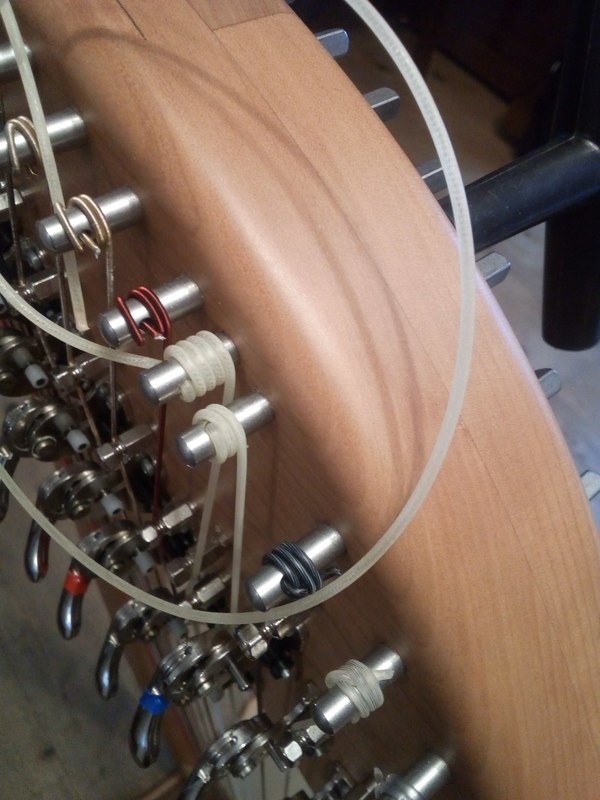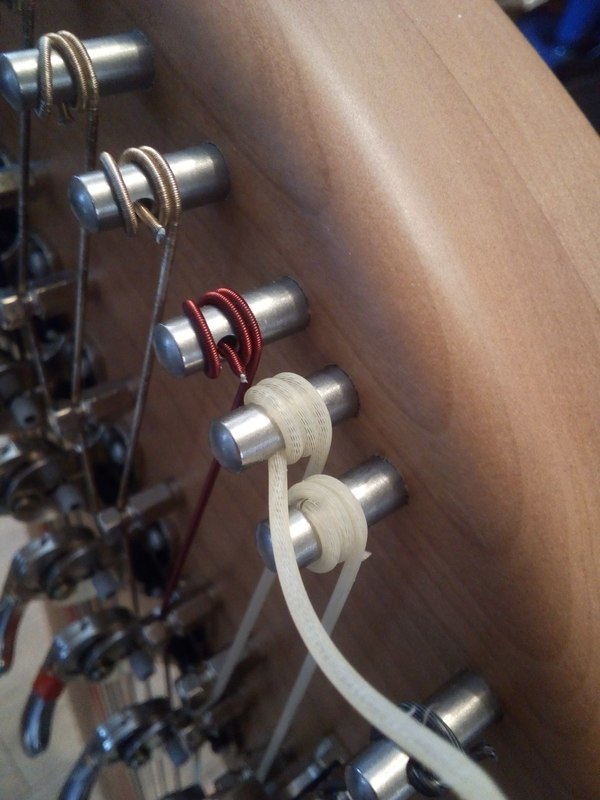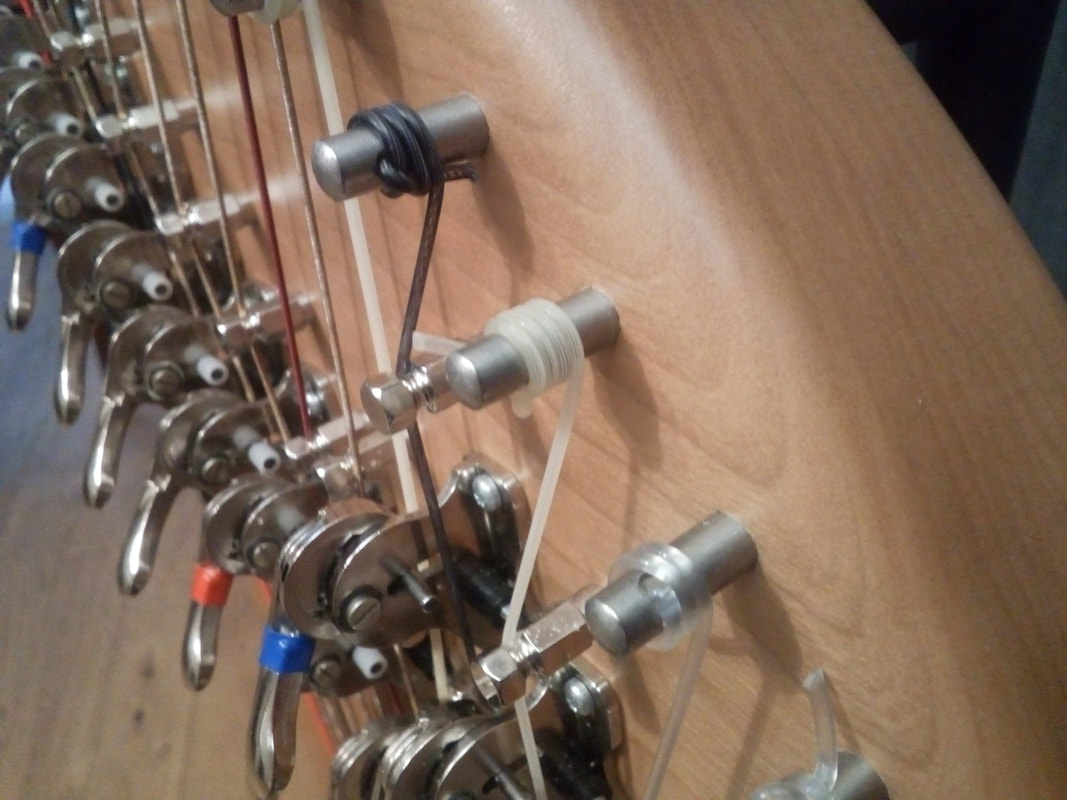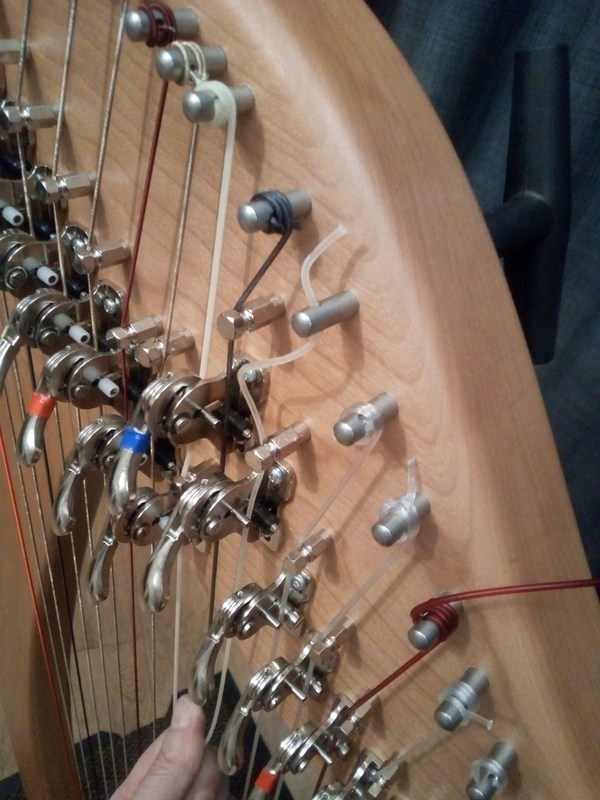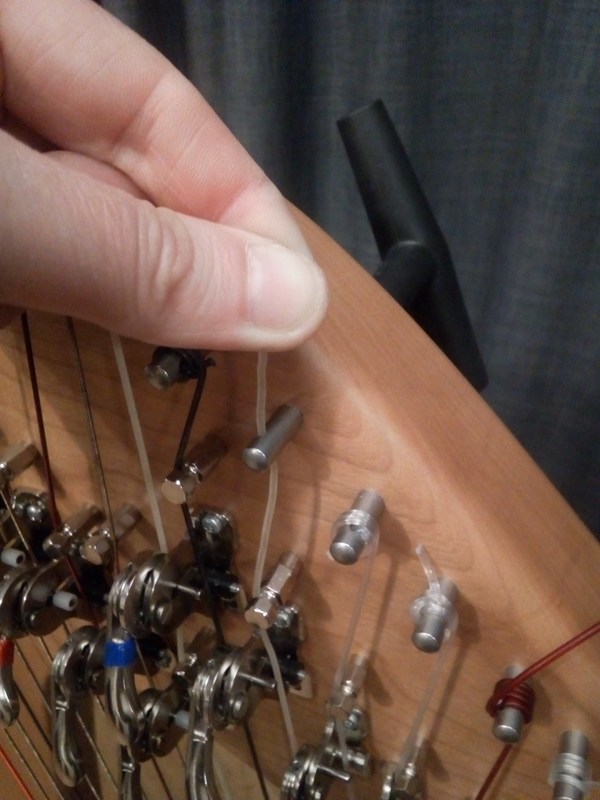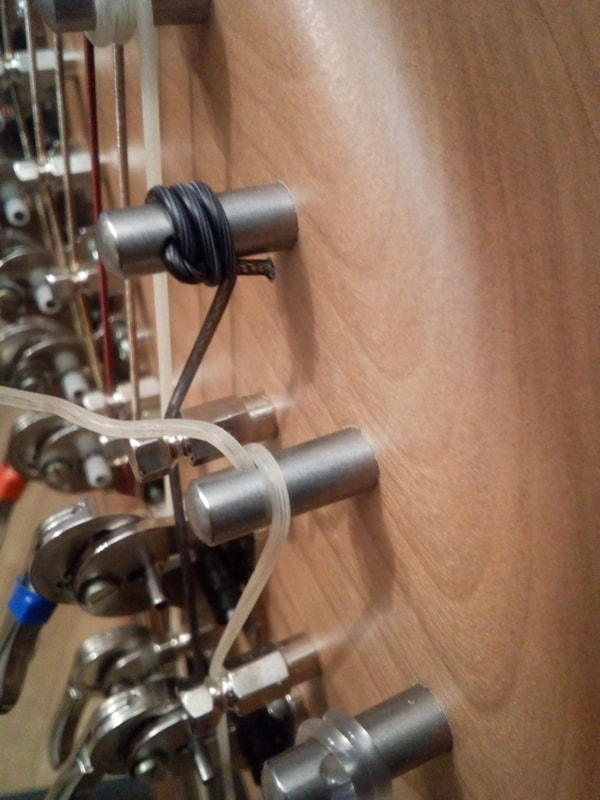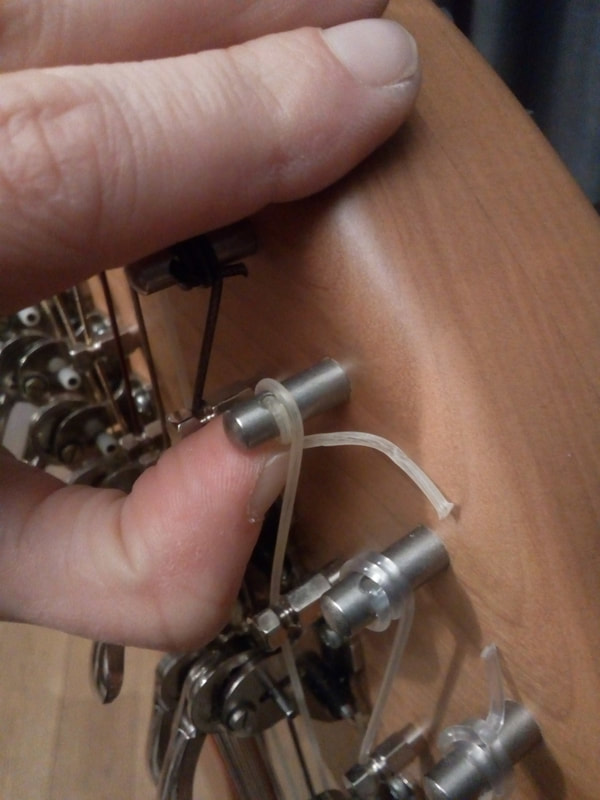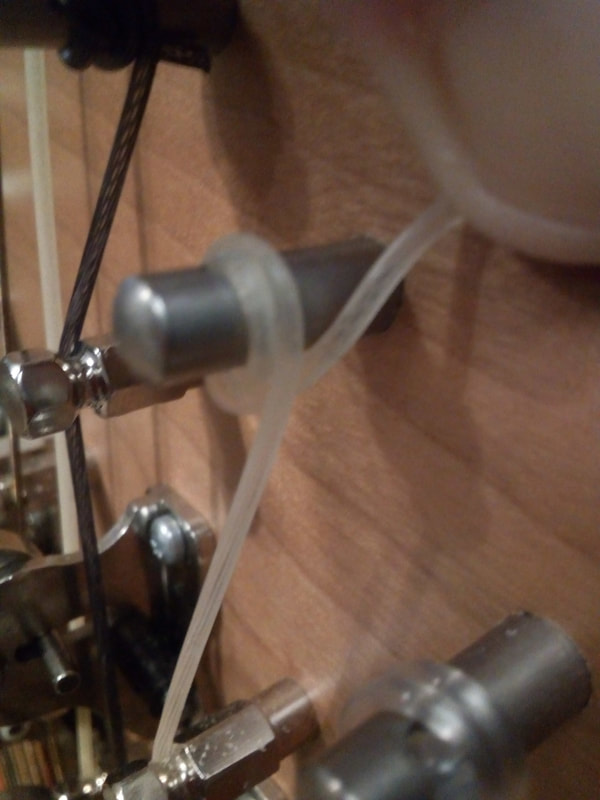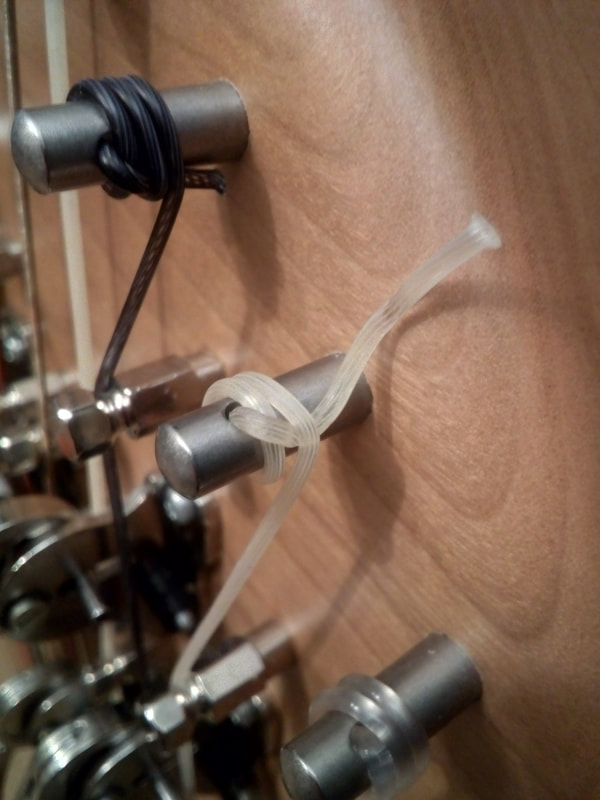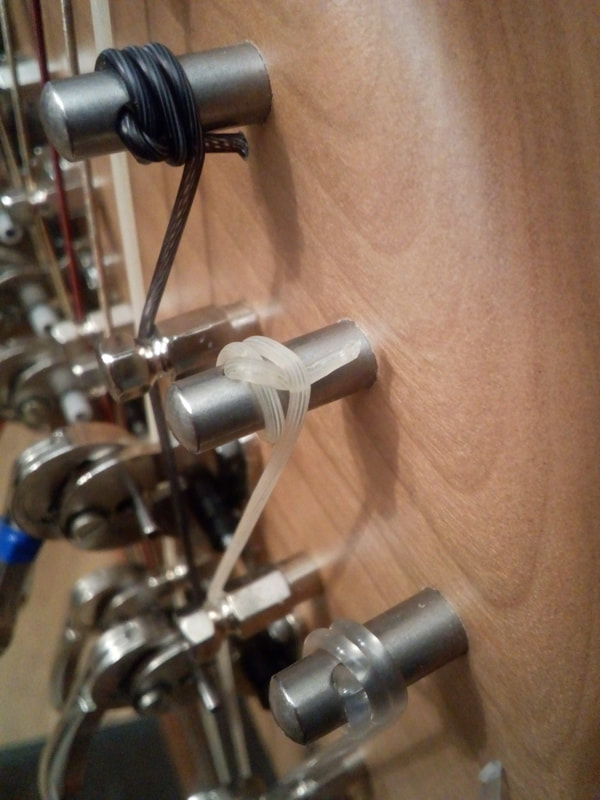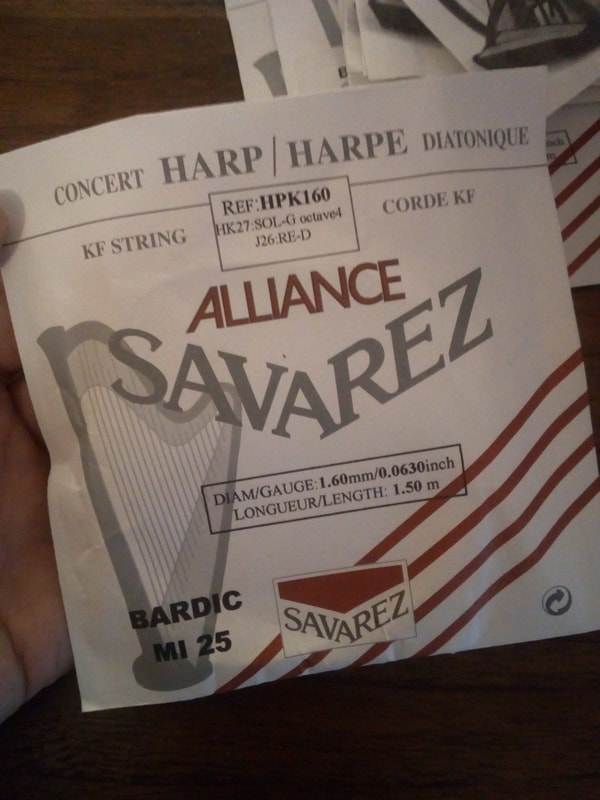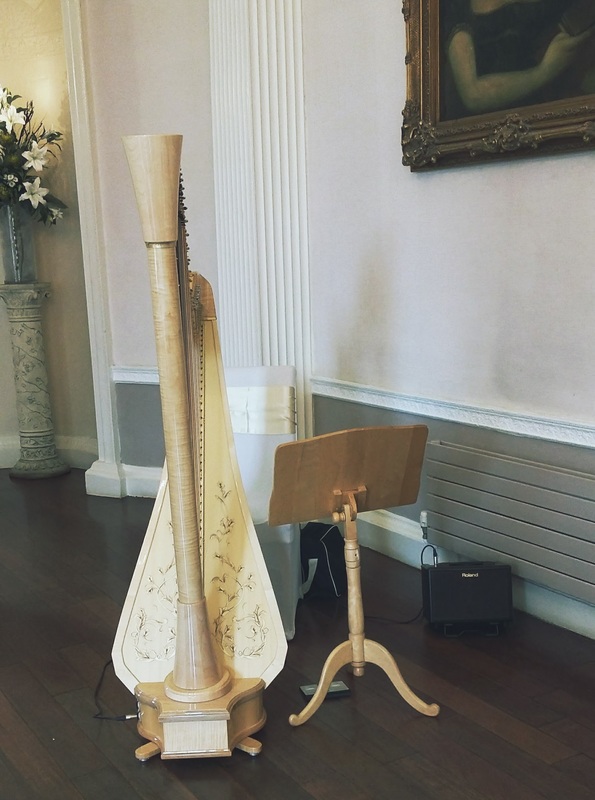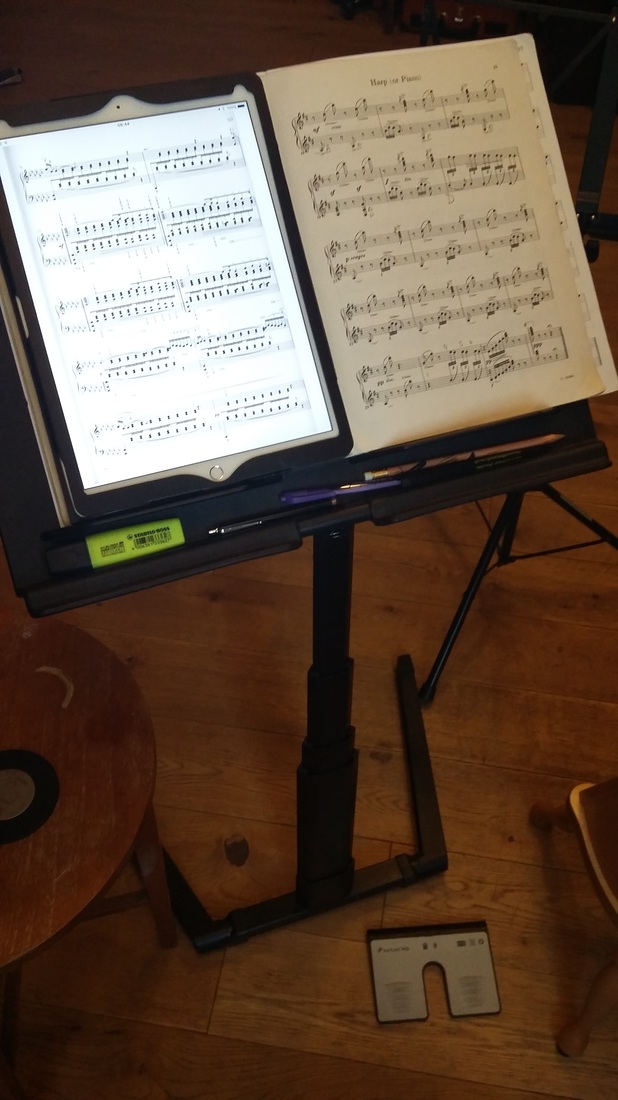|
Inspired by bio-luminescent plankton that glow in the dark, flashing arpeggio figures, the hum of rapid harmonics and a variety of extended techniques evoke this most magical of phenomena to scintillating effect. Sea of Stars was written in January 2020 and premiered by Lauren Scott and Eleanor Turner in an online performance in October 2020. Originally written for lever harp & pedal harp duo, I have subsequently arranged this piece for harp quartet. The quartet version can be played on 4 pedal harps or mixture of lever & pedal harps. Video of how to play the extended techniques in Sea of Stars
0 Comments
I've recently created some practice templates which are available for free from my online shop on this website. It's a learning resource suitable for all musicians (not just harpists) and for any level of player. As such i've created 2 versions, 1 for harpists and a general one for non-harpists. Here is a mock "filled in" version which hopefully gives an idea of how you can use them I'd love you to have a go and see how you get on using them. Please do let me know if you find them useful !
There's more information on how to use them in my web shop. link below A while back, a blind friend of mine asked me to help her with restringing her harp as she had quite a few broken strings. She is a beginner harpist and was struggling a little bit with navigating her way around the harp. I said to her that I would investigate to see if there was a solution, so I got in contact with harp maker Mark Norris. I was making a visit up to Mark's harp studio in Peebles, Scotland so I had a chat to him about it and was delighted that he was up for exploring the possibilities of what could be done. He has been brilliant in finding a solution for her and in the end he developed a special textured varnish to apply to the strings. He sent me the varnish kit through the post and I made a short video explaining the whole process here of adapting the harp. After the harp was finished the big test was getting the harp back to my friend and what she thought about it all. She said that the textured strings were effective and helpful in finding her way round the harp!
It was interesting to see how she played her harp and in her case, it seemed that as well as applying the textured varnish lower down on the strings, it would also have been useful to apply it high up as well. It seemed more natural for her to slide her fingers up the string, rather than down the string to feel the textured guides. To sum up - a thin band of two coats of textured varnish applied in an inch wide band low down on the string were fine on the middle C string and lower. This didn't affect the sound quality of the string. All the strings higher than middle C were better with only 1 coat of varnish. Many thank to Mark Norris for being a total star with his time and effort in developing a solution for my friend. Mark Norris Harps. and order strings online at HarpStrings.Biz On my trip to Scotland to visit Mark Norris's studio he showed me how to tie the perfect harp knot HERE I've been buying my harp strings from Mark Norris for a while now https://www.harpstrings.biz/ and I recently have been chatting to him online about the possibly of adapting some strings to make them suitable for a blind harpist friend of mine. One thing led to another and I told Mark about my own customised string set up and that the intonation of my levers left a little to be desired. I was a bit nervous about telling a harp maker how I had dived in and started customising and playing around with a harp set-up, but he was extremely generous and said that he would have a good look at my harp and fix my levers so that it would be properly in tune! I know Mark doesn't normally look at other makes of harps apart from his own, so it was an extremely generous offer from him. So this meant a long drive to his studio in Scotland which was 8 hours of driving in total there and back from my home. But I took lots of breaks and what a splendid drive it was. I had to stop to take a picture of the view near to his studio. I have to admit to being a complete harp nerd, and visiting a harp makers studio is heaven for me! Absolutely amazing to see a craftsman at work and to see harps in various stages of being built. Whilst I was there Mark showed me a new project of his called Nifty Harps, and they are absolutely fab. He's developing a professional model and I can't wait to order a 27 string one next year. They are affordable harps with a really good sound and have a wrap around detached soundboard. Think along the lines of cardboard harps, but made with rolled wood. An absolutely brilliant project https://niftyharps.scot/ Mark was fitting a string whilst we were chatting and I couldn't believe the speed he went at. So here he is demonstrating tying the perfect harp knot slowly for me, and it's still so quick! Amazing! And to top it all off, Mark fixed the intonation on my harp.
Thank you Mark! We are nearly there with a possible solution on the strings for blind harpists, and I'll post about that another time
I haven't had any broken nylon or carbon fibre strings since I first fitted them. However one of the wires started to go 'curly' in the middle of the string and start to go out of tune. I've never experienced that curly feeling in the middle of a wire string before so I thought it was probably time to change it PDQ. Having replaced that wire string and noticed the difference in sound I decided to change all the wires and multifilament wires.
WHAT A DIFFERENCE those new wires have made!!! The rest of the strings still sound great, so there isn't any need to change them at all unless one breaks (which I suspect won't be for a while), I'll keep an ear on them in case they start to sound dull or out of tune, but so far they all sound good. However I think a refresh of the wires and multifilament wires every couple of years will probably be a good thing as they do seem to wear out. The discerning amongst you might have noticed that my lever harp has an unusual sound and the reason for that is because I have customised the string set up. I've blogged a fair bit on the re-stringing process before here on Harpyness, but I wanted to share what the final string set up is and more importantly WHY I've done this. I've always been after a very particular sound on lever harp, and I really loved the sound of my little 27 string Camac Bardic, but I wanted a 34 lever harp with a slightly brighter sound then the Bardic, I never really found the sound I heard in my head by any of the main harp makers but I had a feeling that the Starfish Glenelle was the closest. Although it is an absolutely FANTASTIC harp, the sound of it wasn't quite what I was after though. I was very fortunate to be given some money by my Dad after my Mum passed away, and he wanted me to do something 'harpy' with it. So after much thought I decided to place my order with Starfish for one of their harps as his gift covered the cost.. I asked them if they would make me a Glenelle but use carbon fibre strings instead of the gut strings which they are designed for. Understandably they weren't keen, but after some persuasion made the harp and strung it with carbon fibre strings. They have a really long waiting list, and eventually the harp arrived which was mega exciting, but it just didn't sound quite right to me with the strings they put on, and some of the strings just kept breaking. I waited about 6 months thinking maybe it would settle in, and the sound would change but it just didn't work. I talked to my Dad about my reservations and that I might experiment with the stringing and he encouraged me to go for it. And so began my re-stringing journey, which I have posted about previously. It's been a slightly scary journey to undertake, and one that I wouldn't recommend as at times it was down right terrifying to be playing about with what is essentially an amazing instrument. The scariest moment was when I had to take off the levers, plug in the screw holes with filler and re-drill new holes to re-sit the levers to get the correct regulation. I felt physically sick during the entire process with the potentially foolhardiness of the whole undertaking. HOWEVER I am absolutely delighted with the result as it's created, for me the sound I was after. The sparkle and lightness you get from nylon in the top range... ...but with enough warmth, earthiness and graduation through the lower register to the bass without any of that brightness you can sometimes get with lever bass wires. ...but with enough strength and "guts' in the strings to be able to cope with me not only playing around doing extended techniques, but also being able to 'give it some welly' and go for it. So WHY do this? This was of course the first question the good people at Starfish asked, what was wrong with the sound of their harp as it was? There isn't anything at all wrong with the sound. The Glenelle is an amazing harp with an incredible sound with gut strings. YES, I could have ordered a Glenelle with their stringing and I would have been really happy with the sound. BUT, and it's a very big but in the equation... Just after my Dad gave me that money he went a bit off the rails and wasn't quite right. To be honest it was a gradual thing over many years but you just don't notice the slide really so no-one was surprised when eventually he got his Dementia diagnosis. He spent years nursing my Mum through her cancer and the caring he did for her towards the end was extraordinary. After her death he really should have had the chance to recover from his caring role and start a new life, but his dementia robbed him of that. TIME is short and you never know what is round the corner. My dad loves music and has a connection to my harp playing. He has good days and bad days, but always loves to hear me play. He's in a residential home now and with regular medication he's in the best place he can be and as happy as someone with sliding dementia can be. Yes I ran the risk of damaging a beautiful instrument, but I also ran the risking of forever regretting and wondering "what if". I had this dream of a particular harp sound in my head. My dads gift enabled me to take this gamble to see if I could find that dream. I've never been one to sit around, but since my Mum passed away and my Dad has slid down the dementia road, I'm a great believer in just going for whatever it is that excites you because you never know what's round the corner. He's been thrilled with the Starfish journey and loves hearing me play on it and I just utterly adore the sound of it. I REALLY don't recommend anyone doing this as I could have ruined the harp. It's been my dream of a sound, and I wouldn't expect it be anyone else's personal taste but my own. So as an aide memoire for me for when I need to order replacement strings here is what I have used. 1st A through to 4th D Nylon Strings for Carmic Bardic harps then Carbon fibre (all Alliance Savarez) from Matthias Wagner http://www.music-strings.de 4th C - HPK136C 4th A & B - KF140A (you can get 2metre length coil of string) 4th G - KF 145 4th F - HPK145B 5th E - KF160 5th D - KF172 5th C - KF180R 5th B, A, G Folk Multi-filament from Salopian Strings (phone only UK 01386 750631) 5th F - Folk wire (for Starfish) from Salopian Strings 6th E-6th C wires from Starfish My earlier posts about re-stringing Part 1 - Part 2 - Part 3 - Wires It's been a wonderful month of networking on Instagram thanks to the lovely harpists at @lowpressureharpshare instigating a month of #harpril posts. It's been a great way to find and meet lots of harpists across the world who haven't necessarily met each other online before. (If you haven't done so already, search #harpril on instagram and you will be in for a treat!) One of the highlights for me, and probably lots of other harpists too, was seeing the posts by @arezoo.amirjamloui and her incredible upside down looking harps - which I must confess to not knowing ANYTHING about prior to seeing them on instagram. @arezoo.amirjamloui referred to them as Iranian harps, (or table harps?) but the Persian Cheng is more curved and these are very straight. Perhaps these are a new modern interpretation of the Cheng? I know they do play what we consider 'normal shaped' harps in Iran, so I've no idea how popular these particular harps in Iran. I would love to know. If you have a link to more info about these harps please do comment below. I've tried to do a websearch on these harps and these harp players but my lack of knowledge of the Persian language is preventing me from doing basic internet research which is frustrating. So - in the spirit of sharing what little I could find out - a bit about the Persian Chang in this next video... and more of these 'table harps" < I wish I knew what there were called!!! > Video taken from this website HERE <disclaimer I don't know whether this is a legit website or not. This video has been re-shared in good faith. I wanted to share the video but it would only let me download the video rather than the standard embed like we have on YouTube videos. Hence me reposting the source link> again <disclaimer - this video has been shared in good faith because I don't understand the language on the website to know who to contact for credit. The video has come from HERE > The Chang is curved so you can reach the upper notes. But it must be hard to comfortably reach the upper notes on these harps? Certainly you couldn't really see them?? More about the CHANG on Wikipedia HERE 24th May 2019 - I've since had some communication with @arezoo.amirjamloui and they are indeed modern interpretations of the Persian Chang and are made (or promoted?) by @shahoo_orchestra www.instagram.com/shahoo_orchestra
Edinburgh based Polish harpist, Zuzanna Olbrys, has excellent resources on her website HERE which are well worth bookmarking to visit regularly. She has written some really interesting articles which I have enjoyed reading.
If you sign up to her newsletter you get a free eBook which I would highly recommend for anyone thinking about learning the harp. It contains very good advice and excellent tips for anyone wanting to learn the harp. Do check it out and sign up for her newsletter HERE
You can hear Zuzanna play on her soundcloud here
A new harp to add to my wish list... a 32 string travel harp built by Alexander Tremer in Germany. Technically it's not a harp because the strings feed to the side, but it's strung and played as one. It only weighs 3.3 kg and it can be carried in a specially designed back pack. I suspect it will also fit into a large suitcase. For a small harp the sound is HUGE as you can hear on this video played by harpist, Amélie Guiboux playing a cover of Get Lucky by Daft Punk on her Luna harp. You can get a good idea about the size comparison with a normal 34 string harp with this picture from the Luna harp website. I've had a quick play on one and despite it looking a little odd (and it not technically being a harp) I'm really impressed. It's well worth having a good look on their website which has lots of info about this harp.
Bertie bonus - it's now comes with Camac levers as standard! https://www.travel-harp.com/ In the continuing saga of the radical re-stringing I'm doing on my lever harp; having changed all the gut strings to carbon fibre & nylon the original wire strings didn't sound great and needed changing. I was very wary of changing the wires and wanted to be super careful as I didn't want to do anything that would endanger the harp. As luck would have it Billy 'The Harp Doctor" was in the area and giving my concert harp a service so I had a chance to pick his brain on the best type of wires to change to now that I had started on this project. So, after a conversation with Billy looking at my harp and then a very helpful conversation with Salopian Strings over the phone, I ordered Multifilament wires for the first 3 wires 5th B, A & G <I had already changed the original 5th C, D & E wires to carbon fibre> and light gauge wire for the final 4 bass strings. So, whats in a multifilament wire string then? Normally you have the metal solid core wrapped in silk and then with the wire (silver, copper etc) wrapped round. As you can see above, there is no solid core!!! Which makes for a very funky & comical looking wire string as you put it on the harp. TBH I really thought that it wasn't going to make any sound at all, but WOW, what a great string. It perfectly bridges that sound gap from the carbon fibre strings above to the wire strings below. I took a gamble on needing 3 of these strings to bridge the gap before moving on to 'normal' wires at the bass end and I'm very glad I did as the sound blends really well. So how bad were the original wires then? Personally I hated the sound of them. The top ones were far too 'zingy' which is why I changed them as soon as possible to carbon fibre and the bottom ones had loads of variation of pitch as you played them. video above the original wires that came with the harp. video below the new hand made wires by Salopian Strings. This is the wire with the solid wire core (not the special multi filament wire). For my personal taste, it's a much more mellow sound with very little 'wow' variation in pitch as it's played. Bear in mind I've literally just put this string on to the harp, so it needs to settle in to pitch. Next up on this project is some adjustment that needs to be made to the intonation with the levers. Some (not all) need adjusting now so that the pitch is true when you change the lever.
After that, I'll be posting videos! The re-stringing I've done so far as been fairly straight forward and now it's on to the experimental side. The strings I've used on the upper part of the harp are all NYLON [shock horror] and sound amazing! I'm really pleased with how they feel and sound. They are all the nylons used on the CAMAC Bardic 27 string harp, which is my other lever harp. I have always loved the feel and sound of the Bardic, so when I decided to change the strings on this harp it suddenly occurred to me that I had a spare set of strings for the Bardic so why not put those on instead? From 4th octave D upwards the nylon strings sound brilliant, but the 4th octave C, B & A sound a bit dead and 'thumpy'. Going towards the bass end the bardic uses carbon fibre but at a different gauge to normal (here comes the interesting bit). Instead of it being lever harp gauge, it's concert harp gauge but used 3 strings higher on the lever higher. As you can see by this photo, the 4th octave G on the bardic is actually a [concert harp] 4th octave B So I tried to source the correct gauge string from a harp shop, which was impossible! So I ended up going to a German luthier string supplier that sold all types of strings for different instruments from the Alliance range. They had a harp section online but instead of the strings being listed by octave they are only listed by string gauge. Luckily they do lots of REDs and BLACKs in various gauges so you can experiment with the gauges. Taking an educated guess, I reckoned that the HPK136R was going to be the one I needed.
The important thing for me was to have no jump in sound from the nylon string on the 4th octave D above to the carbon fibre 4th octave C. Which I'm delighted to say that now it's starting to settle in there isn't!!! PHEW!!! I decided that I didn't like some of the wire strings as they sounded too 'zingy' after the carbon fibre strings so I started to replace a few. I carefully removed the wires without cutting them, so I could always replace them if necessary. I decided to be a bit more methodical with the stringing this time, so I just wound the string on without catching the tail underneath the loops to lock on the pin. I kept tuning it every couple of hours for 24 hours. After 24 hours I carefully unwound it [see last post] and re-strung it so that I lost the excess (stretched) string. I checked it every day when tuning regularly, and after 5 days it looked like this. As you can see from photo above, it's a pretty much a healthy 3 coils round the peg. It still needed tuning constantly over the 5 days; but once that initial stretch is pulled through that seems to be pretty much it.
I'm just going to carefully unwind the string now allowing for it to be turned at the point it's reached now and will tie the tail under so it winds over itself. Next thing is repeating this process with the next wire down which also sounds incredibly 'zingy'. I'm hoping that I can stop there as the B below has a different heavier sound which I think will blend better soundwise. I've been doing some experimental re-stringing on my lever harp and wanted to use carbon fibre strings. My goodness, those strings are slippery & stretchy and handle completely differently from gut strings. So this morning I finally worked out a way of handling them better and here are the pictures. [Never mind the time I spent trying to fix a knot into the carbon fibre string in the first place as it kept slipping apart. I'll post pictures of how I ended up doing the knots later. For now, this post & the pictures are all about the major issue (I think) with carbon fibre strings which is just how incredibly stretchy they are!] When I wound the string onto the peg, there was so much stretch in the string, it took loads of turns to get it to pitch. Then when you left it to settle, it took more turns to get it back up to pitch. It took far longer to get to pitch than a regular gut (or nylon) string. Which meant more coils round the peg. The G string above was not too bad an example in that is was only 4 turns round, but it was still going flat and need another twist round to sharpen to pitch. So I unwound the string making sure to keep the tension by hand as much as possible with the lower part of the string to create as little movement on the knot as possible. Then I pulled the string back up to take out the slack. Then I re-engaged the string to the pin from this new point. Don't leave any slack in the string - trust me it will stretch. I had over 4 cm of extra string when I pulled it through; that is how much stretch and slack had accumulated over a period of 5 days from first putting the string on the harp. After one full revolution to then push the string towards the harp, so that now when it wound on it would lock and wind over itself. The important thing being to then trim the excess, so that eventually you would 'lose' the 'tail' under the coils as it winds on. You might think this all seems blindingly obvious, but trust me, using carbon fibre strings feels SO different to gut & nylon. I think you need to double or triple the time you would normally spend stringing, tuning and settling in the string. HOWEVER... once it's settled and in tune, I think carbon fibre are brilliant strings. ***I am using these on my lever harp but certainly would not think about using these on my pedal harps*** BUT WHY????
Good question. I'll answer that in my next blog post. #Allianz #savarez #carbon #fibre #carbonfibre #strings #KF string #corde KF I can't believe it's been three years since I first blogged about using an iPad on gigs! My set up has changed a bit since my last post so I thought it was time to review what I'm currently using when I play at weddings and private functions.So the main change is that I invested in a new harp a few years back - my amazing electro-accoustic harp, a maple Camac Little Big Blue. JOY What a beauty my Little Big Blue is, as well as being a complete joy to play! It has completely revolutionised my experience of playing at weddings and has made my life so much simpler in so many ways. Being a 44 stringed harp, it is physically so much easier to move around than my big Salvi, plus being amplified it is much easier playing for long periods of time. Playing outdoors is no longer a problem as I can usually find somewhere good (preferably indoors or in shade/covered) and just move the amp to where it's needed. I'm still paying off the loan for the harp, but it was definitely worth every penny. DOUBLE JOY My amplifier is a Roland AC-33 battery powered guitar amp. It's small, powerful and best of all - battery powered. Before I got my Camac I experimented with amps and pick-ups on my Salvi and as well as not being satisfied with the amplified sound, just carting round all the gear was (literally) a pain. Being able to plug just ONE lead from the harp into a battery powered amp and switching the amp on and beautiful natural amplified sound coming out is brilliant. Earlier this year I had to finally accept reality that my eyesight is not getting any better and reading the music on my old iPad wasn't really working too well. Which brings me to... ...the iPad Pro. I'm not an Apple fan, but you have to hand it to them for finally making what musicians needed; a decent sized screen for reading music. My eyes are grateful. Plus there is the extra bonus of not needing a music stand light or pegs to hold down sheet music when playing outdoors. I'm still using ForScore software to view my music on the iPad, so that is still the same as my original blog post, along with using Dropbox to get it onto the iPad. The only change is that I'm now using a bluetooth foot pedal to change the pages of the music as I'm now reading the music '1 up portrait' rather than '2 up landscape'. It's taking some time to get used to an extra pedal to operate with my left foot, but it is well worth it. PLUS POINTS
What's in my bag?
And that's it - all easy, light and quick to carry. Light years away from all the gear I used to carry round with me on gigs. Finally In all the years I've been using an iPad, I have never had a problem with my iPad or the ForScore software. However that hasn't stopped the little nagging worries that somehow 'something may happen' and all the technology might suddenly stop working whilst I'm on a gig. For that reason alone I always carry a very small folder of one hours worth of printed sheet music that lives in the handy zip pocket of my harp cover. I have never had a need to use it. For size comparison - my iPad Pro on my music stand next to an old copy of Ceremony of Carols which is a standard 'oversized' piece of music. Most newly bought sheet music these days are the smaller A4 size which is around the same size as the iPad Pro.
I use the standard model large iPad Pro which is - WiFi only, 32GB 12.9 inch screen which is more then enough space for a massive library of music. I have a recurring nightmare where I look down at my harp and the strings look like this!!! However, this is no bad dream - instead it's an amazing video of a Chopin Mazurka played on a 6x6 cross strung chromatic harp by Dutch harpist, Mirjam Rietberg. To quote from Mirjam's website; 'The 6x6 cross-strung chromatic harp is named this way because it has two rows of strings that cross each other. One row is tuned in whole notes (6 notes in an octave) from C (c, d, e, f#, g#, a#) and the other row is also tuned in whole notes but from C# (c#, d#, f, g, a, b) ' Mirjam has a lovely website here which includes info about the chromatic harp, and also more about the FRIENDS OF THE CHROMATIC HARP here I love the idea of the chromatic harp being used for contemporary music and that she plays jazz on it, rather than exclusively being used to play baroque music. |
Categories
All
AuthorLauren Scott is a harpist & composer and has been blogging on Harpyness for over 10 years. If you enjoy reading Harpyness and you'd like to buy me a virtual coffee that would be very welcome. Cheers!
Archives
June 2024
|
